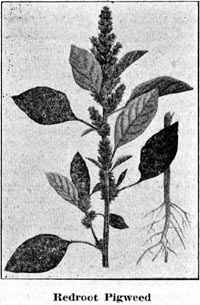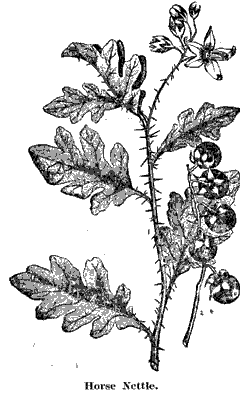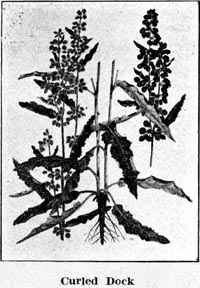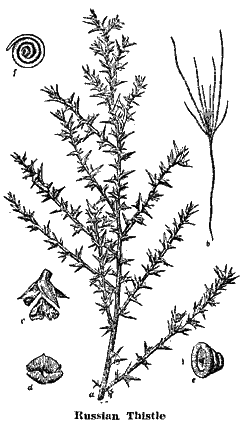NEGenWeb
Project
Resource Center
Schools
|
220 |
|
|
SERIES II. |
BULLETIN No. 18. |
Some Common Weeds and Insects of Nebraska Corn Fields and Potato Patches.

INTRODUCTION
This bulletin is one of the series published jointly by the State Department of Public Instruction and the Department of Farmers' Institutes, University of Nebraska, for the encouragement of the work of the Nebraska boys' and girls' club. The subject matter was written and compiled by A. E. Nelson. The bulletin is designed for the use of members in studying some of the problems in the growing of corn and potatoes. A few of the most troublesome weeds and insects are described.
It is expected that by following the instructions and studying the weeds and insects described, observation and investigation by members will be sharpened and increased to such an extent that they will continue the study of these pests and work out methods and means for their eradication. One is never thoroughly acquainted with a plant until he can call it by name. We recommend that each member learn the names of the weeds studied. The accompanying blanks are intended as a means to aid in observing the essential points connected with the study of weeds.
For many of the illustrations in this bulletin, we are indebted to the agricultural colleges of Kansas, Iowa, and Illinois, from which states the cuts were borrowed. We have also rephotographed some of the excellent illustrations In the text entitled "Weeds of Canada."
One of the most encouraging features of our work is the co-operation of those most interested in the encouragement of good things for the state. This bulletin is printed for us by the Nebraska Farmer Publishing Company as a substantial evidence of their appreciation of
|
|
221 |
the boys' and girls' work in Nebraska. The Nebraska Farmer takes this means of expressing its desire to do all they can for the promotion of the work. The following bulletins relating to the September and October work in the ear to row test and the seed piece experiment and on the acre and husking contest will be sent to all members who make the required reports. The reports on weeds and insects should be mailed not later than August 15, 1910. E. C. BISHOP, State Superintendent Public Instruction. VAL KEYSER, Superintendent Farmers' Institutes, University of Nebraska. July 1, 1910.
WEEDS
The old saying, "The Weed follows the Plow," has stood the test of time and experience. When Nebraska was a wild prairie, unmolested by man, very few weeds were found; but as the plow broke the soil, weeds came in from other states by railroads, by streams, by birds, rabbits, horses, and other animals, until at the present time they have become a serious pest.
Any plant out of place might be considered a weed; for instance, oats or corn in a potato patch could be considered a weed, as such plants would doubtless be injurious to the best development of the potato crop. However, from the farmer's standpoint a weed is "any Injurious, troublesome, or unsightly plant that is at the same time useless, or comparatively so."
Weeds cause considerable loss by:
1. Robbing the soil of plant food and moisture that should develop the crop.
2. Reducing the value of the farm by making it unsightly, unprofitable, etc.
3. Choking out other crops by shading and excluding the sunlight.
4. Increasing the cost of every operation on the farm, as harrowing, fanning, plowing.
5. Harboring many Insects or fungus diseases which later attack cultivated plants.
6. Poisoning or Injuring stock, tainting milk, Irritating the mouth of stock when eating hay containing weeds.
One should always bear In mind that preventing weeds from coming on to the place Is much more profitable and sensible than to try to destroy them after they have once gained a foothold. However,
|
222 |
|
any weed can be destroyed by persistent effort and a perfect understanding of its nature and habits. The farmer should always plant seed that is free from weed seed. No weed seeds should be allowed to mature. When animals are transferred from one farm to another their hair should be carefully examined for cockleburs, burdocks, etc. This Is especially true of horses and sheep. Every precaution should be taken to prevent the introduction of weeds. A short rotation of crops is without doubt the most sensible and practical method of preventing or eradicating most of the common weeds and insects which infest the fields of Nebraska.
CLASSIFICATION AND METHODS OF DESTRUCTION:
Generally speaking, weeds are divided into three classes-annual, biennial, and perennial.
Annual: When speaking of annual plants we mean those which live but one year and then die down. Black Mustard, Great Rag Weed, and Foxtail for examples. These can be destroyed by stopping the production of seed. However, it will be necessary to watch them very closely, as the seeds of some annual plants can live in the ground for a number of years. As these seeds are moved near the surface of the soil by plowing and harrowing they will begin to grow. Therefore, by merely cutting off the tops each year and thus preventing seeding, one only reduces the number of weeds. If the plants have been allowed to seed, some farmers practice burning off the dead weeds and in doing so destroy a great many of the seeds that would otherwise form plants. They then plow shallow, leaving the. seeds near the surface. This causes the seeds to germinate quickly, when they can be destroyed by shallow cultivation.
Many farmers do not put any crop on the land when they are treating it as mentioned above, but in most sections this is considered a needless waste. Crops that can he cultivated the greater part of the season, such as corn, potatoes, beets, cabbage, etc., can be raised at the same time that the weeds are being destroyed without materially Interfering with the operation.
These annual weeds usually grow where the ground has been plowed. Therefore, it does not seem wise to allow ground to remain without a crop after it has once been broken. Sometimes such weeds as Foxtail, Barnyard Grass, and many others are often allowed to go to seed in gardens, potato patches, etc. These can be destroyed by mowing a short time after the harvesting is done.
Biennials: These are plants that live two years and then die. They spend the first year in storing up nourishment which they use the second year in producing a good crop of seeds. A great many biennial plants, such as radishes, have fleshy or taproots. Examples of biennial weeds are wild carrot, burdock, and wild parsnip.
These plants are often caused to spread or send out more shoots when cut off above the ground. If cut off below the crown with a
|
|
223 |
spade, dandelion digger, or hoe they generally die. In the fall of the first year one will often see biennial plants sending up small shoots upon which to produce next year's seed. They should be cut below the crown with some sharp instrument at this time, as they are more tender than they would be a year later.
Biennial weeds are easily destroyed by putting the ground into such crops as beets, corn, potatoes, etc. They are, however, often found in fence lines, old hay meadows, waste places, etc., where it is impossible to cultivate. In such places the mower, spade, fire, etc., can be brought into use.
Perennials: Plants which live from year to year for an indefinite length of time are called perennials. Some of the immense trees in the forests of California and Mexico are known to be hundreds of years old. Canada Thistle, Soap Weed, Quack Grass, and Yellow Dock are examples of perennial weeds. Some perennials die down each winter, while others keep a rosette of green leaves above the ground the entire year.
Many of these plants not only produce seeds, but also have "underground stems" that travel through the soil and send up shoots at Irregular distances. Quack Grass, Milk Weed, and many other weeds are propagated in this way. Others reproduce themselves by sending out roots wherever a joint of the stems touches the ground. To destroy weeds of this class, all production of seeds must be stopped and In most cases the roots and other parts below the surface of the ground must be destroyed. The production of seeds can be prevented by mowing before the seeds are formed. One must pursue different methods when destroying the portion below the ground, as much depends on the size of the piece of ground infested, the character of the plant and soil, etc. The following suggestions can be beneficially employed when combating weeds of the perennial class.
Where only small plots are affected, tar or building paper can be laid on the ground over the plants, and small pegs driven into the ground along the edges to hold the paper in place. The roots can also be dug up and removed. Certain chemicals, such as crude sulphuric acid, coal oil, and Carbolic acid have been used very successfully, their great drawback being the expense necessarily involved when applied. When the plot is near the barnyard it is often advisable to place a hog lot over it. If the hogs are fed on the worst infested place they soon stamp out the weeds. Another method commonly used in pasture is to place lumps of rock salt on the areas affected. The rains dissolve the salt, which either hinders materially or entirely destroys the weeds. As the cattle generally visit the salt several times in the course of a day, they stamp out the remainder of the weeds.
The building of hay and straw stacks upon small patches has met with limited success. Sheep, hogs, and the unlimited use of the hoe and spade are to be recommended. In fact, any method that will keep the plant from coming above the ground for one season will destroy It forever. Where larger areas are infested, "smother crops"
|
224 |
|
are often used. Examples of these crops are Hemp, Buckwheat, Millet, Cane, Milo Maize, Sorghum, and Kaffir Corn. When this method is to be employed, the ground should be stirred from early spring until the crop is sown. This cultivation can best be done with the plow, disk, and harrow. When the plow is used it should be very sharp, otherwise the roots and vines are dragged to other parts of the field where they may again start to grow, hence enlarging the area infested. Sow the seed at such a time as will encourage quick germination. The heavy foliage of the! plants cover the ground, excluding sunlight and air. If a piece of ground infested is properly planted to smother crops two or three years in succession, the soil will be left practically free of all obnoxious weeds.
(Genus-Helianthus)
The different varieties of sunflowers of Nebraska are so well known that little description is necessary. They are rough, annual plants, growing from four to ten feet in height. Their leaves are ovate with rough edges and very distinct veining. The flowers appear from July to September, and are brownish in the center with a fringe of yellow sepals. The sunflower is reproduced by angular grayish-white seeds about one-half inch long.
Owing to the long period of time the sunflower seeds will retain their vitality in the ground, they are especially hard to eradicate. As the plant is an annual, any method that will stop the production of seeds each season will in the end destroy the pest.

|
|
225 |
(Genus-Amaranthus)
This weed is an annual with a pinkish fleshy taproot; grows from two to four feet high and has a rough prickly stem. The leaves are ovate in shape and heavily veined. The pale green flowers appear in bunches. The seeds are circular, shiny, and of different shades of black. They are commonly found in all grass seeds and are its only means of spreading. The methods commonly employed in destroying annuals--pulling, preventing the production of seed by mowing, short rotation of crops, etc.--will destroy pigweeds.
(Genus-Solanum)
The horse nettle is seldom injurious in Nebraska except in the eastern part. This plant spreads rather slowly, as the seeds are very seldom found in commercial seeds. Practically the only method it has

|
226 |
|
of spreading from one section of the country to another is by means of birds.
The purplish white flowers of the horse nettle which appear from June to October resemble those of the potato, to which it is closely related. It grows from eight to twenty-four inches in height and its branches are covered with stiff hairs and sharp spines or "stickers." The leaves are shaped somewhat like those of an oak tree and have spines on the larger veins. The seeds are produced on the branches in little berries. The plant is also reproduced by rootstocks which send up shoots at irregular distances. This plant thrives best in loose, sandy soil which is easily penetrated by its roots and it is very little affected by ordinary cultivation. It can be destroyed by pulling, grubbing, and spudding and by the use of smother crops.
(Genus-Rumex)

There are many kinds of docks but the two most common in this section are the pale-leaved and the curled. Both are perennial. The leaves of the pale-leaved species are somewhat paler and larger than the curled, wrinkled leaves of the curled variety. The pale green flowers appear during June and August. The angular seeds are ripe by September. The hull surrounding the seed is so constructed that the seeds float easily. This is the chief reason why docks are so commonly found on low or overflow ground.
|
|
227 |
Pulling by hand when the ground is wet is one of the most successful methods of eradicating the pest. However, when they are too numerous the spade and mower must be used. Care in planting clean seed and when possible a rotation of crops are the best preventives.
(Genus-Satsota)

The Russian thistle is an annual
found in nearly every part of the state. Once it was thought to be
one of our most serious weed pests, but at the present time it is not
so considered. It is a much-branched plant that grows from one to
three feet high. As the plant matures it becomes more spherical in
shape. The flowers are small and not easily detected. The seeds are
dull gray in color, irregular in shape, rather small, and are
commonly found in commercial grass seeds. In the fall, the plant
breaks loose at its base and rolls over the ground, scattering seeds
at every bound.
8
 |
 |
 |
 |
|
© 2003 for the NEGenWeb Project by Ted & Carole Miller |
|||